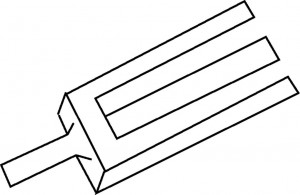
I love what I do, and by that I mean being an audio engineer. I’ve been recording, mixing, and playing with sound since I was in my early teen years, and I am still the happiest when I’m sitting at a console, mixing something beautiful and sensing the energy of it flowing beneath my fingers. It’s an invigorating, energizing feeling.
Mixing is an art. You can learn to operate an audio console in a few minutes, but to train your ear and learn the subtleties that separate passable mixing from really fine mixing takes years. That’s why after a concert, theatre production, or broadcast, I feel the same sense of accomplishment that the musicians do. I played my instrument well, as well as anyone else in that chair could have. Maybe better.
Here’s the thing, and it’s what makes my art a little different from the musician’s art. When my job is done correctly, I am invisible and inaudible. I am generally sequestered in a space far from the audience. No one sees me. And if I do my job well and correctly, not a single person will be conscious of hearing anything I do. Good mixing presents the music to the audience faithfully and transparently; it never yells, “Hey, listen to me!”
Negative attention is easy to garner. If I draw a big, ugly feedback squeal, every head in the house will turn in search of a target for the stink-eye I so richly deserve. If I miss a mic cue and an actor’s line isn’t heard, I have just made my existence known in a way I will forever wish I hadn’t. But if I’m doing it right, I’m not there.
That is not to say that what I do isn’t rewarding. There’s an old movie about a golfer called “Tin Cup,” and in it, the central character, Roy McAvoy, played by Kevin Costner, Â has a line that’s both cheesy and introspective.
“A tuning fork goes off in your loins. Such a pure feeling is the well-struck golf shot.”
I know that feeling!
Mixing, like so many things in life, is about balance. Any fool can make every voice and every instrument heard. The skill and the challenge lie in layering and blending those sounds together with a respect for the character and timbre of each, and striking the one perfect balance between them. When you’ve got 6 or 8 instruments, several backing vocals, and a soloist, for example, there exists a “sweet spot” for each of them. And in live mixing, you’ve got to find that sweet spot right away, and hang onto it as the song changes and flows. It’s a moving target, and your search for it is like a mathematical asymptote — you’ll approach it ever more closely, but you don’t actually expect to ever quite get there.
But sometimes — for a fleeting, wonderful, sublime moment — I do get there. For a second, or a few seconds, or at some rare times for a whole song, I manage to strike and hold that perfect balance. Every sound is in its place. Every voice is perfectly blended with the others. The vocals themselves are floating along atop an ideal blend of instrumental music, smooth and powerful. And a chill runs down my spine; there is an actual, physical feeling of joy and elation! It’s not exactly a tuning fork, but it’s a sensual, almost orgasmic feeling, coupled with an intense concentration as I tweak the faders, knowing that even a tiny move, a fingernail’s thickness, can make or break that moment.
At those times, it doesn’t matter to me that no one notices what I’m doing. Out of a house of 500 or more people, there might be one or two who will notice the subtle difference between a good balance and that elusive near-perfection I’m feeling. Maybe no one will, but I notice. And that feeling, that wonderful shiver I get is addictive! Feel that just once and I can promise you’ll want to feel it again.
Someone asked me once why I do so much mixing for live theatre, and particularly for musicals. Fearing I might not be able to express this as I’m doing now without sounding like a lunatic, I dodged the question. But why indeed? Setup is hard. Tech week is grueling and exhausting. Giving up several weekends straight is inconvenient at best. There must be a reason, and there is. It’s those moments.
Those moments, when the house is full and the stage is alive with color and light and the microphones bring lovely sounds to my console, and I’m honing and sweetening and adjusting and turning them into exactly what I want to hear and sending them back out to the audience in a fiery, sizzlingly hot mix and that tingle is running up and down my spine, those moments! They are my reward, my passion, my addiction, my weakness, my reason for continuing to come back, again and again. When I don’t mix for a while, those moments are what I miss. Actors and directors talk about “post-show depression,” and I know exactly what they mean, because I feel it, too. I want to be back behind the console. I want that feeling again.
The audience will never know me. No one clamors to meet the tech crew after a show. But they will  have felt my gift to them, born of my quest for perfection and my pursuit of Roy McAvoy’s tuning fork. And when a compliment does come, I take it to heart. When someone takes the time to compliment the work of an invisible man, I know that someone shared those moments with me. That gives me great pride.